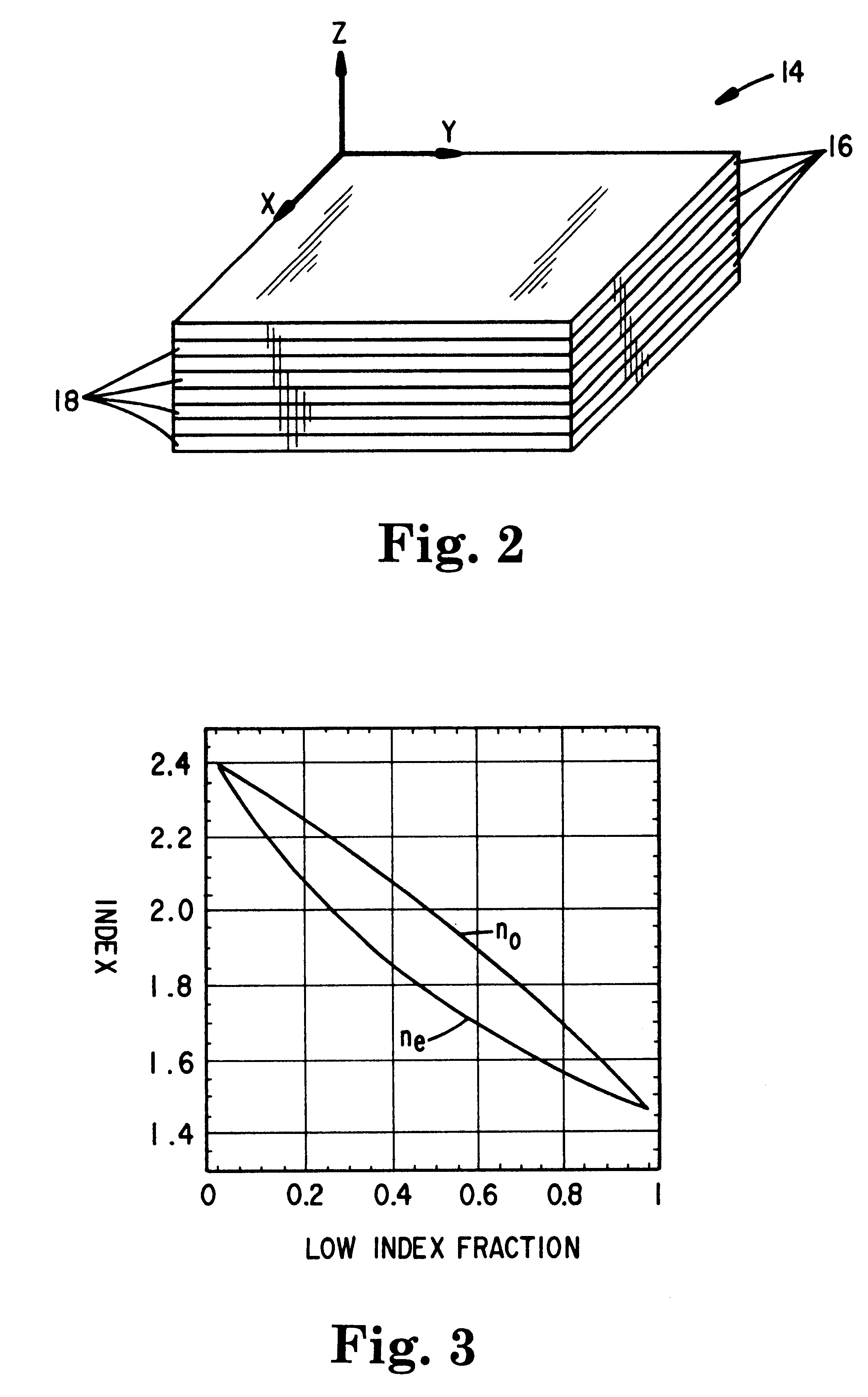Birefringent reflectors using isotropic materials and form birefringence
a technology of isotropic materials and reflectors, applied in the field of reflectors, can solve the problems of difficult to meet certain stringent flatness specifications, processing techniques and/or polymeric materials, and difficulty in making low film volumes economically
- Summary
- Abstract
- Description
- Claims
- Application Information
AI Technical Summary
Benefits of technology
Problems solved by technology
Method used
Image
Examples
example 1
Mirror Film Having 16 Microlayer Negative Unaxial Optical Layers Alternating with Isotropic Optical Layers
In this first example, 8 pairs or 16 microlayers total were used in each 1 / 4 wave form birefringent optical layer. The microlayers, with indices of 1.46 and 2.4, thus have thicknesses of about 6.88 and 8.12 nm respectively. This corresponds to a low index material fraction of about 0.46. The effective indices of this composite layer are approximately 2.04 (in-plane) and 1.80 (out-of-plane). This form birefringent layer alternates with a 126 nm thick isotropic optical layer of index 1.82. The stack is immersed in a 1.70 index medium. FIG. 11 shows the calculated transmission spectra at normal incidence (curve 38) and at 45.degree. for s- and p-polarized light (curves 40 and 42, respectively).
Note in FIG. 11 that the fractional bandwidth and peak height for p-polarized light is the substantially the same at 45 degrees as at normal incidence in a high index medium of index 1.7. For...
example 2
Another Mirror Film Having 16 Microlayer Negative Uniaxial Optical Layers Alternating with Isotropic Optical Layers
The left bandedges of s- and p-polarized light in FIG. 11 can be brought into closer coincidence by an adjustment in the refractive index of the intermediate index material. This Example 2 mirror film therefore was of the identical construction as the Example 1 film, except that the refractive index of the isotropic optical layer was changed from 1.82 to 1.77. FIG. 13 shows the resulting spectra, where curve 44 is for normally incident light, and curves 46,48 are for s- and p-polarized light respectively that is incident on the mirror film at 45.degree.. The normal incidence and s-polarization reflectivities are stronger due to the larger in-plane index difference (2.04-1.77 versus 2.04-1.82). The p-polarization band is slightly weakened because of the deviation from the z-matched condition in the direction of isotropic stacks. Instead of changing the intermediate index...
example 3
Mirror Film Having 4 Microlayer Negative Uniaxial Optical Layers Alternating with Isotropic Optical Layers
In Example 3, the number of microlayers are reduced even further. This multilayer mirror film was of the same construction as that of Example 1, except the form birefringent optical layers each consisted of only 2 pairs, or 4 microlayers. The microlayers were four times as thick as those of Example 1, thus maintaining the low index fraction of 0.46. The thickness of the isotropic optical layers was maintained at 126 nm, and the index maintained at 1.82. With this construction, the spectra of FIG. 14 are obtained. Curve 50 is for normally incident light, and curves 52,54 are for s- and p-polarized light respectively that is incident on the mirror film at 45.degree.. As seen, the p-polarization reflectance band is slightly narrower, and the left bandedges for s and p-polarized light are substantially aligned. The weaker p-polarization reflectance compared to FIGS. 11 or 13 indicat...
PUM
 Login to View More
Login to View More Abstract
Description
Claims
Application Information
 Login to View More
Login to View More - R&D
- Intellectual Property
- Life Sciences
- Materials
- Tech Scout
- Unparalleled Data Quality
- Higher Quality Content
- 60% Fewer Hallucinations
Browse by: Latest US Patents, China's latest patents, Technical Efficacy Thesaurus, Application Domain, Technology Topic, Popular Technical Reports.
© 2025 PatSnap. All rights reserved.Legal|Privacy policy|Modern Slavery Act Transparency Statement|Sitemap|About US| Contact US: help@patsnap.com



